Key takeaways:
- Feedback is vital for artist growth, fostering creativity, and building confidence through constructive criticism.
- Effective feedback should be specific, empathetic, and framed as an opportunity for dialogue, allowing for deeper engagement.
- Creating a comfortable environment and taking time to reflect on feedback are essential for meaningful exchanges.
- Starting with positive comments and remaining open-minded during discussions can enhance the feedback process and strengthen creative connections.
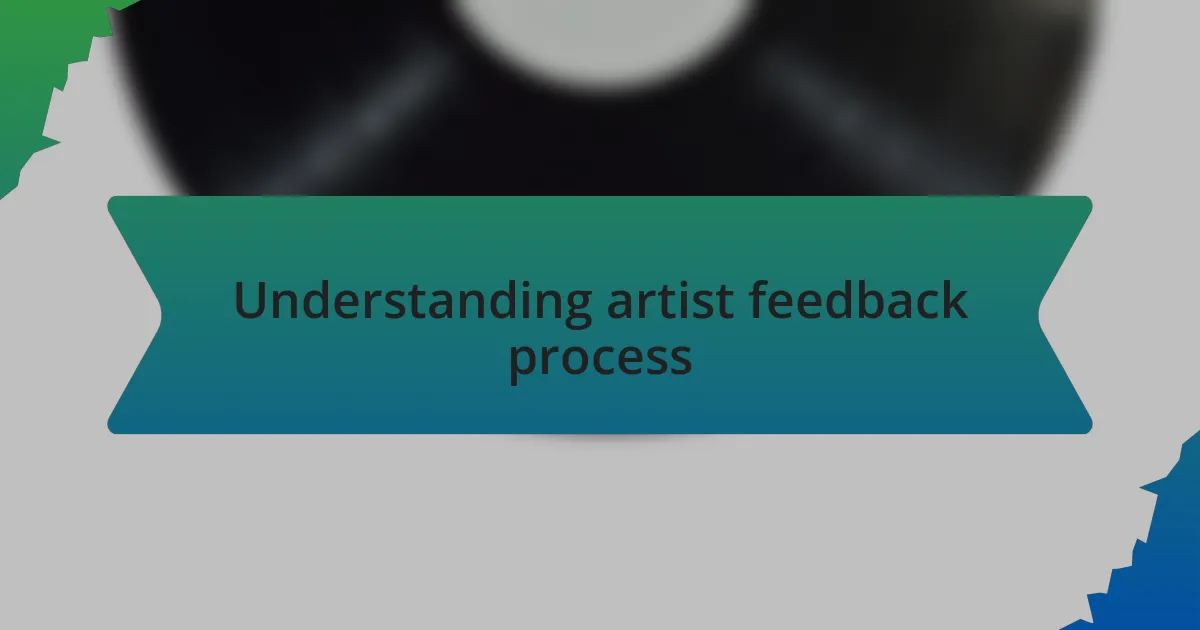
Understanding artist feedback process
Understanding the artist feedback process is crucial for fostering creativity and growth. I remember a time when I shared an early demo with a group of artists, and the range of feedback I received was both enlightening and overwhelming. Each perspective not only shaped the final track but also opened my eyes to how varied our artistic visions can be.
Listening closely to an artist’s interpretation of feedback can unveil hidden layers of emotion in their work. There was a moment when an artist reacted to my critique with frustration, and it made me realize that feedback isn’t just criticism; it’s an invitation for dialogue. Have you ever felt like your insights were misinterpreted? It’s essential to clarify intentions and nurture those conversations for both sides to learn and grow.
The feedback process is not one-size-fits-all; it varies greatly among artists. I often ask open-ended questions to encourage deeper discussions, as I’ve found that engaging in back-and-forth conversations reveals more than formal reviews ever could. How does the artist want to feel with their music? This kind of inquiry often leads to richer outcomes than simply pointing out strengths and weaknesses.
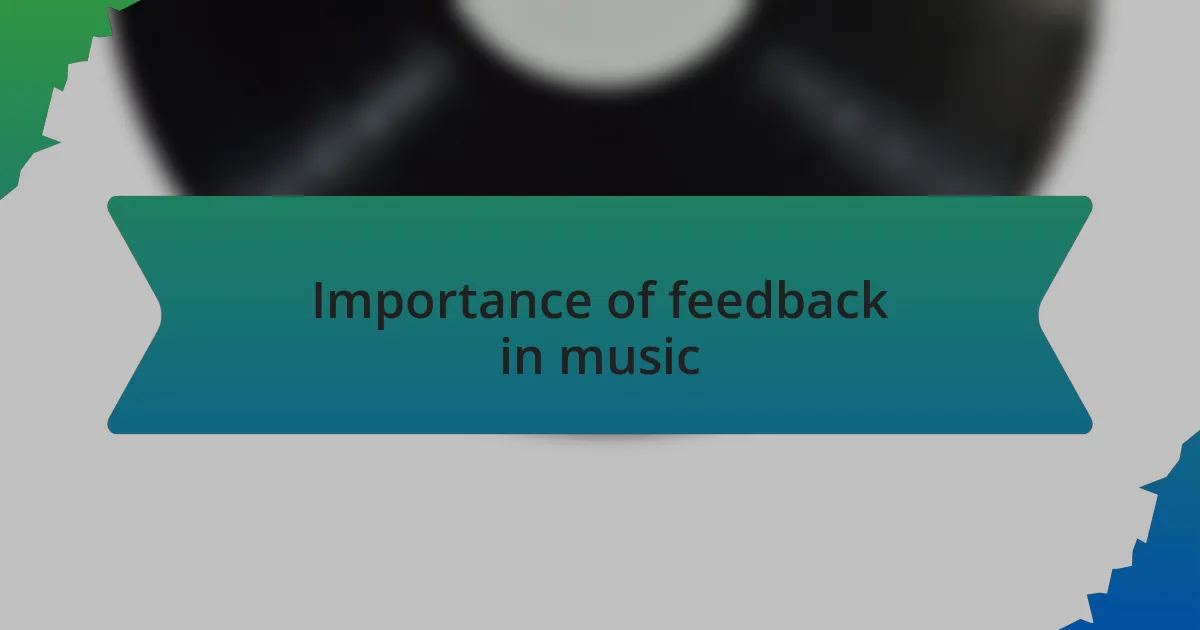
Importance of feedback in music
Feedback in music is essential for evolution. I’ve personally witnessed how a single piece of constructive criticism can ignite a creative spark in an artist. For instance, after suggesting a shift in a tempo for one of my collaborative projects, the artist transformed that track into a completely new journey, showcasing how feedback can breathe life into mundane sounds.
Understanding the importance of feedback also plays a pivotal role in building an artist’s confidence. I recall a session where an artist doubted their potential but, after discussing their lyrical themes in-depth, they realized the strength of their message. Have you ever felt that your voice might not resonate, only to discover it’s your uniqueness that makes it powerful? That moment of realization can pivot someone from self-doubt to self-assertion.
Moreover, feedback cultivates a sense of community among musicians. In my experience, sharing raw drafts and inviting honest reactions often leads to valuable connections. When we engage openly, it transforms feedback from a critique into a collaborative growth experience. Isn’t it fascinating how constructive dialogue can not only improve music but also deepen relationships?
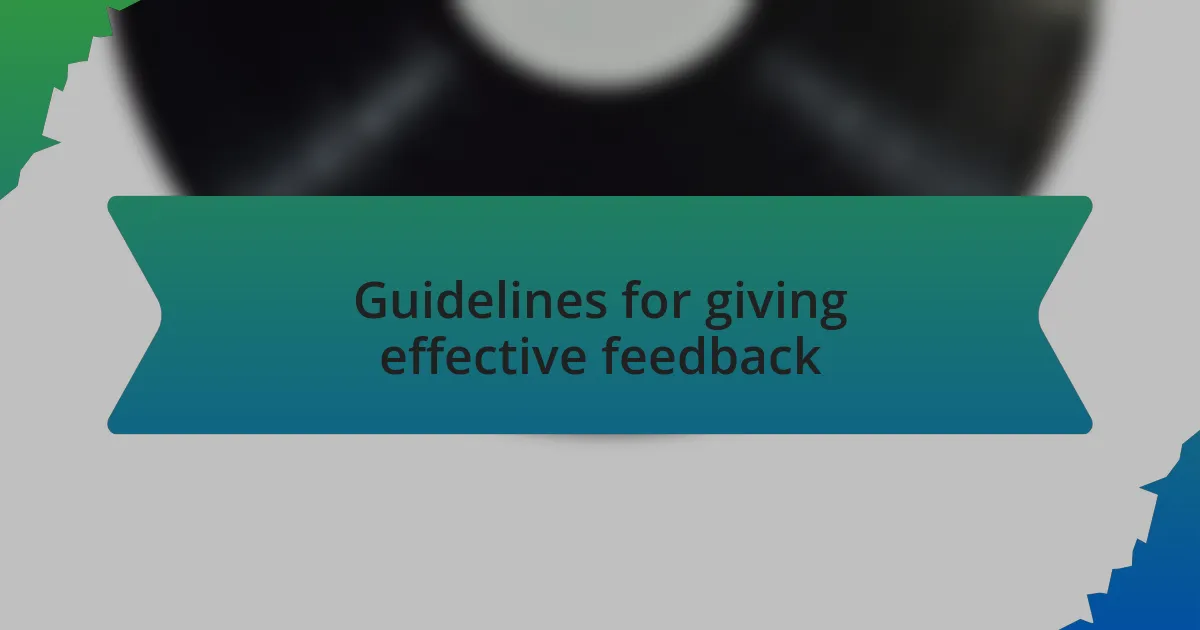
Guidelines for giving effective feedback
When offering feedback, I believe clarity is key. It’s crucial to be specific about what works and what doesn’t. For example, instead of saying a melody “needs work,” I might suggest, “The melody feels a bit flat in the chorus—maybe experimenting with a higher note could bring it to life.” This not only clarifies my point but also provides a potential solution, making the conversation more productive.
Empathy plays an important role too. I remember once working with an artist who was incredibly vulnerable about their lyrics. Instead of just critiquing the words, I took a moment to acknowledge the emotions behind them. I said, “Your story is powerful; how can we tighten it without losing that raw feeling?” This approach calmed their fears and opened the door for a genuine dialogue. Have you ever noticed how understanding emotional intention can drastically reshape the feedback experience?
I also find it helpful to invite a two-way conversation during feedback sessions. After offering my thoughts, I often ask, “How do you feel about these suggestions?” By fostering an open-ended dialogue, I create space for artists to express their perspectives, leading to a more collaborative and enriching interaction. It’s amazing how such a simple question can turn an ordinary session into a transformative experience, don’t you think?

How to receive artist feedback
Receiving feedback from artists can be a delicate process, and I’ve learned that setting the right environment is essential. I remember a session where the artist was particularly nervous about sharing their work. By choosing a comfortable space and starting the conversation with positivity, I noticed their defenses lowered, allowing for a more honest exchange. Have you seen how a relaxed atmosphere can completely change the tone of feedback?
To ensure clarity and actionable insights, I often ask artists specific questions about their vision. For instance, rather than simply asking for their thoughts on a produced track, I might say, “What emotional journey were you hoping to convey through this song?” This not only helps me understand their intent but also invites them to articulate deeper feelings that might inform the feedback. I find that engaging directly with their aspirations provides a richer context for our discussions.
Lastly, I’ve discovered that timing matters when absorbing feedback. In my experience, it’s beneficial to take a moment to reflect after receiving input. I once worked with a talented artist who, after hearing my suggestions, needed a few days to digest them. When we reconvened, their reflections added layers to our discussion. How often do we rush past our initial reactions without letting them settle? Taking that pause can transform feedback into a more profound and meaningful exploration.
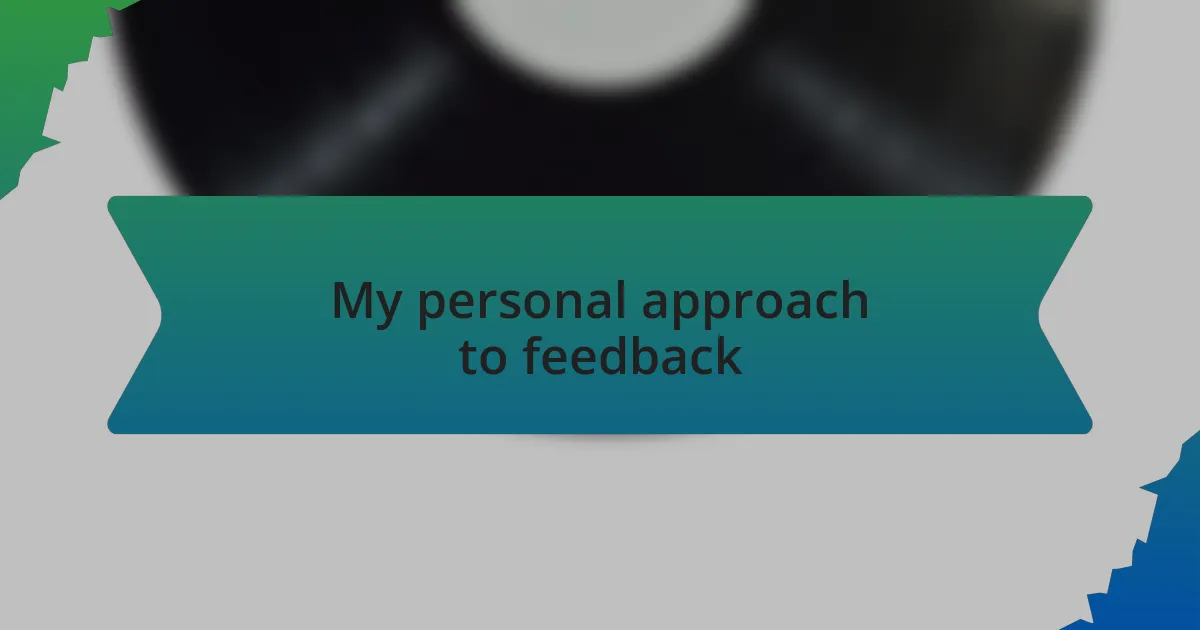
My personal approach to feedback
When it comes to feedback, I believe in approachability and openness. I recall a particularly impactful session where I sat down with an emerging artist who was struggling with vulnerability. I shared my own experiences of doubt and hesitation, which not only eased the tension but also encouraged them to express their feelings more freely. Isn’t it fascinating how relating our struggles can create a safe space for honest dialogue?
I also place great emphasis on the emotional aspect of feedback. For instance, during one discussion about a song that included deeply personal lyrics, I asked the artist how those words made them feel. Their eyes lit up as they described the emotions they experienced while writing, sparking a profound conversation. Have you ever noticed how emotions can illuminate the underlying message in a piece of art? I find that digging into these feelings often reveals insights that technical critiques alone might miss.
Additionally, I’ve learned that embracing constructive criticism is a crucial part of growth. I once received feedback that stung initially, but after sitting with it, I realized it pushed my work to a new level. Have you ever faced a critique that felt harsh at first but later became a catalyst for creativity? Sharing these experiences while guiding artists not only fosters resilience but also cultivates an environment where both of us can learn and grow together.
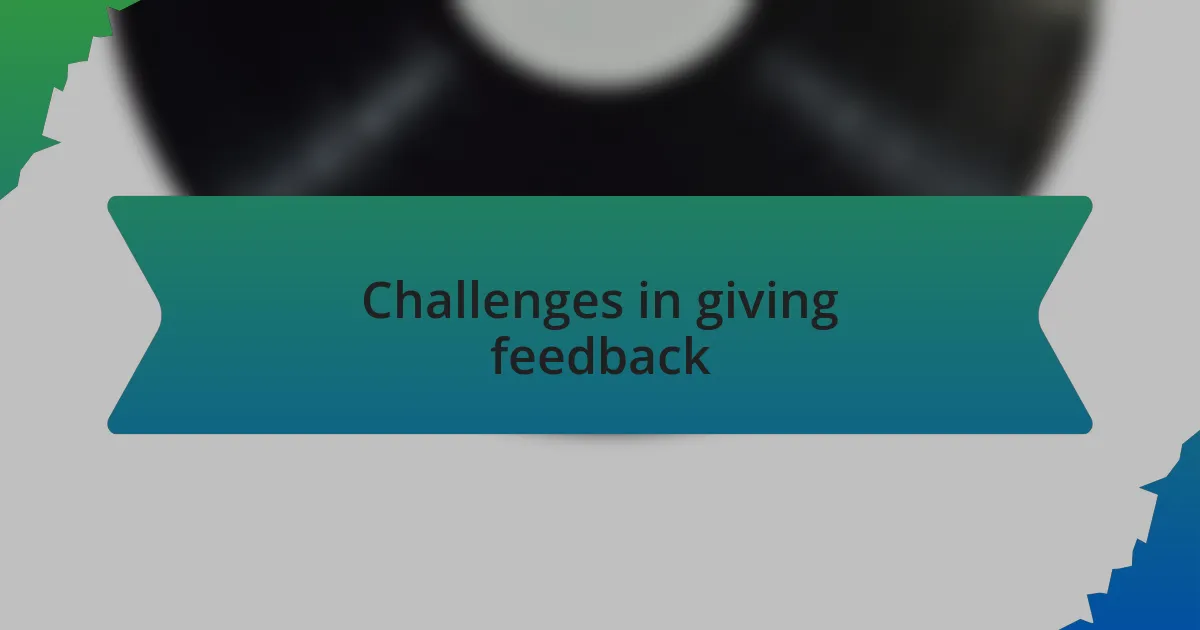
Challenges in giving feedback
Providing feedback can often feel like walking a tightrope. There’s a fine line between being honest and risking the artist’s confidence. I recall a time when I needed to address a repetitive melody in a track. I approached it delicately, framing it as an opportunity for creativity, but I could sense the artist’s anxiety. Have you ever had to confront a situation where you worried your words might discourage rather than inspire?
Another challenge lies in balancing the technical and emotional aspects of feedback. Once, I reviewed a song where the instrumentation was technically flawless, but the lyrics fell flat emotionally. It was tough to convey that the song lacked a certain depth without dismissing the artist’s hard work. I found that asking open-ended questions led to a more productive conversation. Isn’t it interesting how a simple question can unlock an artist’s true vision?
Lastly, timing is crucial when giving feedback. I remember a late-night session when a tired artist showed me their latest work. I hesitated to provide my honest assessment, realizing that fatigue could cloud their judgment. Sometimes, I wonder if sharing feedback in the wrong moment can lead to misunderstanding. Have you ever noticed how the timing of your words can change their impact entirely? It’s a delicate dance, and I strive to be sensitive to the artist’s emotional state while still being honest.
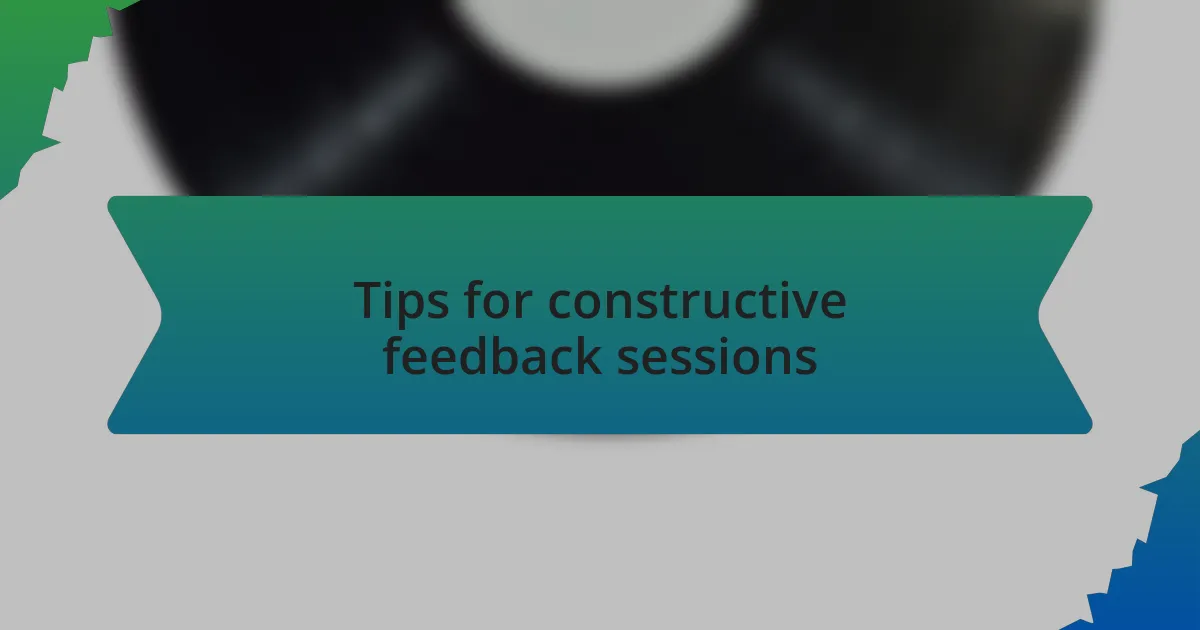
Tips for constructive feedback sessions
One effective tip for constructive feedback sessions is to begin with the positives. I remember a particular session where I shared my appreciation for an artist’s unique vocal style before diving into the areas needing improvement. It’s amazing how highlighting strengths can create a supportive atmosphere, making the artist more receptive to suggestions. Have you ever noticed how starting on a positive note sets the tone for more productive discussions?
Another strategy is to make your feedback specific and actionable. In one instance, instead of saying a chorus was “too repetitive,” I pointed out which sections could benefit from variation. This not only provided clear guidance but also encouraged the artist to explore their own creativity. It’s fascinating how specific pointers can spark fresh ideas, don’t you think?
Also, stay open-minded during the discussion. I’ve had moments where an artist shared a perspective I hadn’t considered, which transformed my understanding of their work. By keeping the conversation fluid and inviting input, the feedback session can evolve into a collaborative exchange of ideas. This approach not only fosters trust but also deepens the creative connection. How has engaging in a two-way conversation changed your feedback experiences?